Prescribers aware: a cross-sectional study from New Zealand emergency departments on the substances used in intentional self-poisoning and their sources
Eeva-Katri Kumpula 1 5 , Bruce Lambie 2 , Paul Quigley 3 , Shyamala Nada-Raja 4 , Pauline Norris 11 School of Pharmacy, University of Otago, Dunedin, New Zealand
2 Department of Emergency Medicine, Dunedin Hospital, Dunedin, New Zealand
3 Department of Emergency Medicine, Wellington Regional Hospital, Wellington, New Zealand
4 Department of Preventive and Social Medicine, University of Otago, Dunedin, New Zealand
5 Corresponding author. Email: eeva-katri.kumpula@otago.ac.nz
Journal of Primary Health Care 12(3) 235-243 https://doi.org/10.1071/HC20017
Published: 21 July 2020
Journal Compilation © Royal New Zealand College of General Practitioners 2020 This is an open access article licensed under a Creative Commons Attribution-NonCommercial-NoDerivatives 4.0 International License
Abstract
INTRODUCTION: Intentional self-poisoning or self-harm through poisoning, is a common cause of presentations to emergency departments (EDs). National datasets do not allow identification of the substances most commonly used in hospital-treated intentional self-poisoning in New Zealand, nor do they capture sources of these substances.
AIM: To investigate the specific substances used in intentional self-poisoning and the sources from which they are obtained.
METHODS: In this cross-sectional study, information about the demographics and presentation particulars of intentional self-poisoning patients aged ≥16 years, presenting to three public EDs, as well as the substances they used in the self-poisoning event and the sources of these agents, were collected prospectively.
RESULTS: A total of 102 patients were recruited from the potentially eligible 1137 intentional self-poisoning patients presenting to the three EDs during the study period. Seventy per cent used their own prescription medications and 24% used medicines they purchased themselves. Paracetamol and ethanol were most commonly encountered substances. Patients presented a median of 1.9 h after exposure (interquartile range 1.0–3.3 h), 62% self-referred, 60% presented to the ED in the evening or at night and 66% were triaged into Australasian Triage Scale 3 (to be seen within 30 min). Two-thirds were referred to emergency psychiatric services.
DISCUSSION: Collecting specific substance information, such as from this study, can assist in planning specific activities to prevent intentional self-poisoning. As most people used their prescribed medicines, the findings can inform and assist doctors in their prescribing practices when they manage patients at risk of self-poisoning.
KEYwords: clinical practice; drug poisoning; patient safety; prescription medicines; risk management; suicide
| WHAT GAP THIS FILLS |
| What is already known: Intentional self-poisoning is a common form of hospital-treated self-harm. |
| What this study adds: Most people use their own prescribed medicines in intentional self-poisoning. Paracetamol and ethanol are the most common substances involved in hospital presentations due to self-poisoning. |
Introduction
Intentionally self-inflicted injuries are a significant cause of population morbidity and mortality, and intentional self-poisoning is the most common type of intentional self-harm injury seen in New Zealand emergency departments (EDs).1 Intentional self-poisoning is defined as the intentional ingestion of more than the prescribed or advised amount of any medicine, recreational drug, non-ingestible substance or excess alcohol for self-harming purposes, regardless of whether there is evidence of intent to die from the poisoning.1 Current New Zealand national data on hospital presentations (National Minimum Dataset, NMDS) uses International Statistical Classification of Diseases and Related Health Problems 10th Revision (ICD-10) codes to indicate the cause of presentations. These codes record broad groups of medicines, but not specific substances.2 Further, there is no information collected on how or where the substance was obtained. International evidence suggests that ease of access is key to substance selection in intentional self-poisoning, and although people may choose to take medicines prescribed to someone else if they gain access, most use their own prescribed medicines.3–6 This information is not available for New Zealand, but overseas evidence indicates that prescribers should be offered information about the risk that medicines they prescribe may be used for self-poisoning. This risk needs to be balanced with patients’ convenience of access to medicines they need for successful pharmacotherapy.7,8
The aim of this study was to identify the most common substances used in intentional self-poisoning, and to investigate the sources of these agents. This study was conducted to contribute to drug policy discussions and to inform prescribers and public health agencies of self-poisoning behaviours in New Zealand.
Methods
Study design and settings
In this prospective, cross-sectional study, we collected information about the specific substances used by 100 patients presenting to three New Zealand public hospital EDs with intentional self-poisoning. A statistically representative sample of EDs was not attempted, but rather a purposeful sample of different locations: a capital city locality (Wellington Regional Hospital), a regional centre (Dunedin Hospital) and a smaller regional locality (Southland Hospital, Invercargill).
Selection of participants
Participants were aged ≥16 years, able to give informed consent to participate and presented with intentional self-poisoning. ED clinicians collected the data. They used their best clinical judgment and introduced the study to a study patient only after they were medically cleared and no longer intoxicated or in acute crisis. We excluded patients presenting due to a purely recreational overdose (no self-harming intent evident), patients who were severely unwell and transferred to other wards such as the intensive care unit (ICU) and patients who were in an acute mental health crisis or otherwise not safe to be approached. A total potentially eligible sample of intentional self-poisoning patients was determined by a manual check of the patient management system by local clinicians, except for Southland, for which only a NMDS count was available. The NMDS describes hospital presentations with a duration of at least 3 h, potentially missing shorter presentations.
Measurements
Demographic variables: Age, sex, residence (rural or urban), self-identified ethnicity, marital and employment status were used. For analysis, we used prioritised ethnicity, where multiple ethnicities are reduced into one.9
Presentation particulars: We collected mode of arrival and source of referral to ED, pre-existing conditions, presentation time, Australasian Triage Scale (ATS) code,10 time of discharge, length of stay at ED, where patients went when discharged from ED (depart destination) and psychiatric referral.
Substance details: We collected substance names and amounts taken, timeline of exposure, sources of substance(s) and means of obtaining substance(s). Amounts of substances were converted into multiples of defined daily dose (DDD) if a DDD value describing a typical daily maintenance dose was available.11 A conservative approach was adopted and if amounts taken were given as a range, the lowest reported amount was used.
Data analysis
Data were de-identified before analysis with SPSS (version 22; IBM, New York, NY, USA) and Excel (2013; Microsoft Corporation, Redmond, WA, USA). As data were not non-normally distributed, medians are given for variables.
Ethical approvals
This study was approved by the University of Otago Human Ethics Committee (Health; ref. H16/043) and was conducted in accordance with the Declaration of Helsinki.12 Locality authorisations were obtained from each study site and participants gave written, informed consent to participate.
Results
Data were collected in Dunedin for 535 days (May 2016 to October 2017), in Wellington for 416 days (September 2016 to October 2017) and in Southland for 199 days (March to September 2017). A total of 1137 patients may have been eligible for inclusion in the study during this time. A total of 131 patients were approached and although 29 declined, 102 were recruited: 73 from Dunedin, 24 from Wellington and five from Southland EDs. The median age of participants was 21.5 years (interquartile range [IQR]: 18.3–29) and their demographic characteristics are described in Table 1. The study participants had a median of one pre-existing condition (IQR: 0–1; Table 2) and close to two-thirds had presented to the ED between 6pm and 6am (Table 3). The participants stayed at the ED for a median of 6.0 h (IQR: 4.0–10.2; six participants’ values were missing) and 15 participants (14.7%) stayed for < 3 h. Psychiatric referrals were made for 94 participants (92.2%).
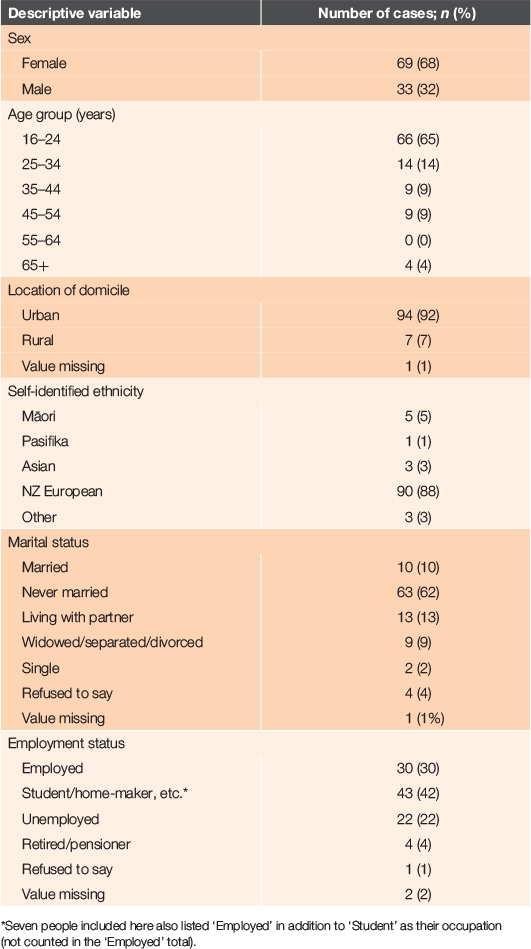
|
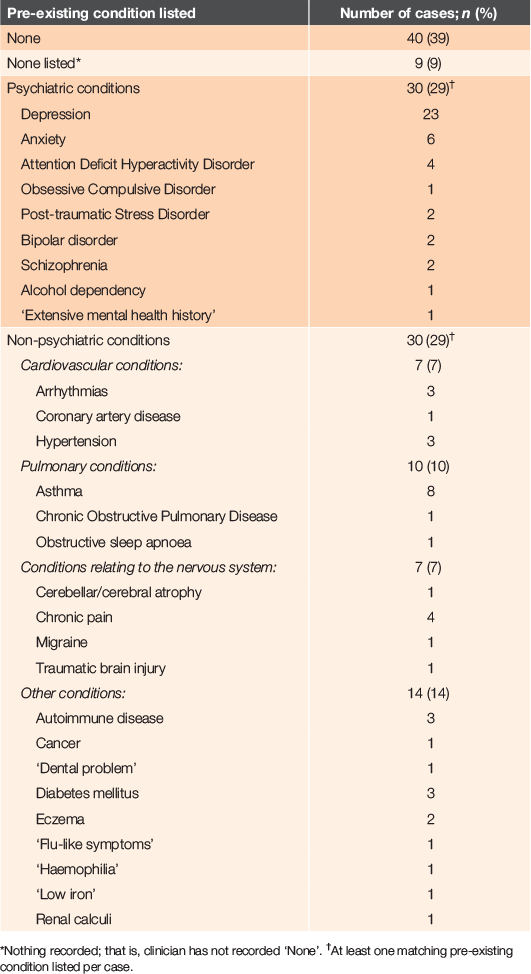
|
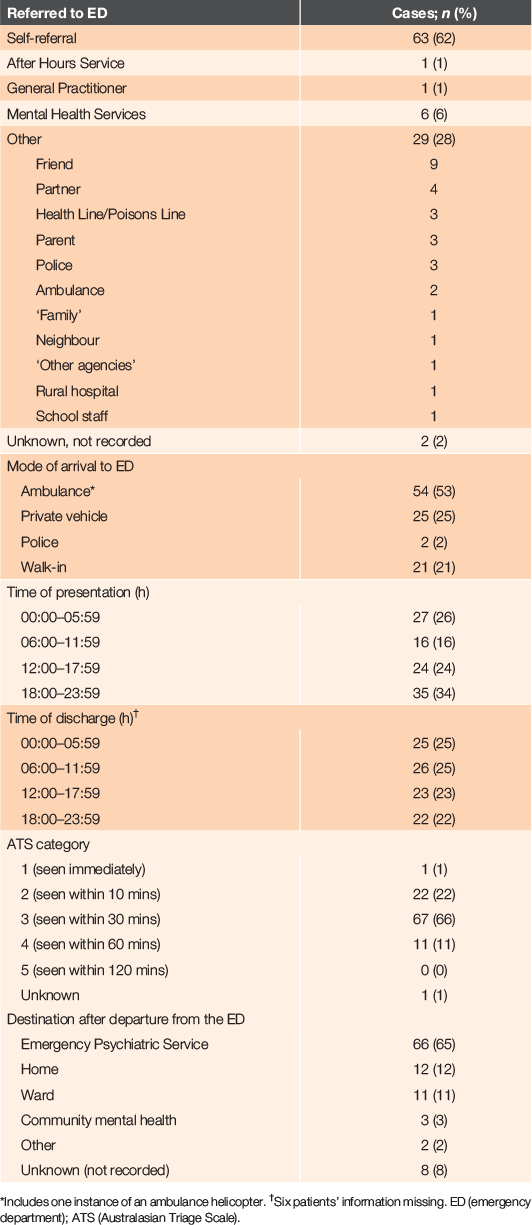
|
Participants had taken a self-reported median of two substances (IQR: 1–3). These presentations involved taking a median of 24 tablets (IQR: 14–49; range: 5–220) and a median of 15 tablets of an individual substance (IQR: 7–29; range: 1–120). The 15 specific substances most commonly taken by the participants are shown in Table 4.
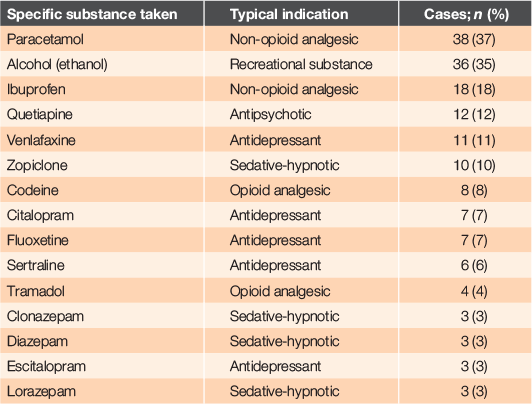
|
Participants were exposed to a median total load of 8.2 DDD (IQR: 3.7–18.3) and individual substances had a median dose value of 4.5 DDD (IQR: 2–10). The median amount of paracetamol exposure was 3.3 DDD (IQR: 2–4.3), which is equivalent to 10 g (20 × 500 mg tablets). The time of substance ingestion was available for 50 patients (49.0%). These 50 patients ingested the substance(s) 1.9 h (median; IQR: 1.0–3.3 h) before presentation to the ED.
Most participants self-reported that they had used their own medications in the intentional self-poisoning event (Table 5). Participants often used medications that had been specifically prescribed to them or which they had purchased themselves. A total of 19.4% of cases appeared to have a psychotropic medication and 8.2% a non-psychotropic medication taken in the overdose, which was recorded as being prescribed to the person, but no matching pre-existing condition was listed.
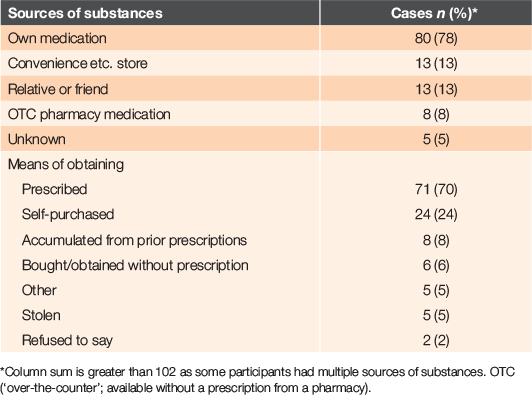
|
Discussion
Our study sample was primarily young, and only one-third had a pre-existing non-psychiatric condition listed in the NMDS. One-third had a psychiatric illness listed, which is much lower than a previous finding of 92.0% in intentional self-harm presentations to the ED in a study from the United Kingdom,13 or a finding of 81.2% in young people and 83.9% in adults from a recent international review.14 Skegg has suggested that intentional self-harm presenters to EDs may be ‘over-diagnosed’ with psychiatric illness due to the diagnostic interview structures used,15 but we cannot exclude the possibility that the prevalence of psychiatric illness may have been under-reported in our sample, which comprised only 9.0% of potentially eligible patients. No details were available on patients who were not recruited and patients excluded due to being in severe distress or requiring ICU-level care and who may have taken different substances and had different diagnoses. When the pre-existing conditions and the medications used in the intentional self-poisoning that were prescribed to patients were compared, in some cases, there were no clear indications listed to match the medications. This does not necessarily indicate inappropriate prescribing, but may rather reflect insufficient transfer of information from primary care to the ED, or imprecise data collection by the clinicians in this study. It was not possible to investigate this in the de-identified study material, but availability of relevant medical record details throughout the chain of care (primary to tertiary and vice versa) warrants investigation.
The study sample was very urban and does not therefore necessarily describe the experiences of people engaging in intentional self-poisoning in more rural locations where access to care and services may be more challenging. Access to community pharmacies, for example, has declined in the past decades in New Zealand.16 Characterising intentional self-poisoning in rural areas of New Zealand warrants further study.
Participants mostly self-referred or were referred to the ED by a lay person such as a partner or a family member, similar to previous evidence from Australia.17 Only one-fifth of the participants were referred by a professional service, which may indicate the less toxicologically serious nature of these intentional self-poisoning events, as indicated by two-thirds being triaged into ATS 3. If the clinical effects experienced by the participants were not severe, they may not have felt the need to seek help from their primary carer, such as a general practitioner (GP) first, especially if it was late at night and their own GP may have been unavailable. As patients who may have been affected by a more severe poisoning and referred to the ICU were excluded from the current study, we were unable to characterise their referral pathways to compare with our study sample. Further, we do not currently know the experiences or full extent of people engaging in intentional self-poisoning in the community setting where the exposure does not lead to seeking formal help at a medical facility. A recent review found that less than half of young people engaging in intentional self-harm seek formal help, and even fewer report receiving help as a result.18 The extent and characteristics of non-ED-treated intentional self-poisoning should be investigated to assess need for services for people not presenting to an ED.
Participants presented 1.9 h after exposure, which is close to the 2–6 h observed in previous studies.17,19 This time frame would allow interventions such as activated charcoal and antidote infusion; for example, in the case of paracetamol overdose.20 Similar to previous New Zealand research, participants mostly presented in the evening and at night.19 Nearly all patients received a referral to psychiatric assessment from the ED, which is similar to a previous study from Wellington.21 The median length of stay was 6 h, which should offer sufficient time to engage the Emergency Psychiatric Service, which was available 24/7 at all study locations. After presentation at an ED due to intentional self-poisoning, letters are normally sent to patients’ primary carers. Investigating engagement and interaction within and between these services and follow-up care received would be a logical extension of this current study.
This study met its aim of determining the most frequently encountered substances in intentional self-poisoning and their sources. As formularies and regulations differ between countries, local data are needed, and this study fills this gap. The substances encountered closely matched a recent study from a Wellington ED, reporting on all overdoses and misuse of medications,22 as well as other studies from the UK23,24 and Ireland.25 Paracetamol was the most frequently encountered substance in all of these studies, and the median dose taken in this present study, 3.3 DDD, was close to the 4.0 DDD observed in a UK study,23 and could warrant antidote treatment.20
Similar to the current study, previous research from Ireland25 and Australia,26 and older data from Auckland27 and Christchurch,19 have indicated that people used their own prescription medications in intentional self-poisoning. The data from Auckland suggest that people make impulsive choices and use what is easily available to them.27 Prescribers should be mindful of potential risk of intentional self-poisoning in their patients and, if applicable, consider alternative medications that are less toxic in overdose, or weekly dispensing, tailored to patients’ specific needs. The present study found a high prevalence of paracetamol and ibuprofen, which may be obtained both without and by prescription, but participants mostly indicated it was by prescription. Other psychotropic medications identified in the study are available by prescription only, emphasising the importance of prescriber awareness of risk of intentional self-poisoning while managing care. Collecting informative data on these poisonings from the EDs such as in this study assists in national policy responses to prevent intentional self-poisoning. Reducing pack sizes of paracetamol available without a prescription in the UK reduced the number of large overdoses.28 Australia limited codeine-containing products to ‘prescription only’ from February 2018,29 and this prompted a New Zealand review of codeine availability, which is still ongoing.30 Such pharmacovigilance activities need to be informed by specific information about substances that need to be targeted. Current ICD-10 codes describing substance groups in the NMDS do not tell us which substances are the most problematic, and more specific data such as those in this present study need to be collected.2
Limitations
Suicidal or self-harm intent was not quantified in this study for practical reasons. We relied on the clinicians’ decision to include the study patients. If a patient chose to take part after reading the study information package, which specified that this was a study of intentional self-poisoning, they likely considered their own presentation to be intentional self-poisoning as well. This, however, could not be confirmed from another dataset such as NMDS due to the de-identified nature of the study. Only 12% of potentially eligible patients at the three sites were approached about participation, but some possibly eligible patients may not truly have been eligible due to an ongoing mental health crisis, for example. Patients who chose not to take part or who were not asked about participation (for example, if their self-poisoning required ICU-level care or who were severely distressed and could not be approached) may have had different experiences using different substances, but due to ethical issues, no details could be collected about them. Due to the de-identified nature of the study, we also cannot exclude the possibility of people appearing multiple times in the dataset after multiple presentations, potentially skewing the results as the total study sample was relatively small.
Patients’ medical history was recorded by the clinicians based on a varying degree of access to previous primary care and mental health notes, patient self-reporting and always previous ED presentation notes (if applicable). We are unable to determine the completeness of the reported pre-existing conditions as a result. Clinical observations together with a history from the study patients were used as a basis for identifying the substances involved in the intentional self-poisoning event. Although some substances may have been missed, direct questions to patients are generally considered a reliable method.24,31 We cannot exclude the possibility that a participant chose to omit some sources of intentional self-poisoning substances; for example, if they involved illegal means. When describing doses that were taken, using DDDs only describes amounts as multiples of the commonly used daily dose, and does not describe the medical ‘seriousness’ of the exposure.32 A future study should investigate exposure doses per kilogram of patient weight to better assess potential for toxicity.
Conclusions
People being cared for after intentional self-poisoning at three New Zealand public hospital EDs presented fairly soon after the exposure, and used mainly their own prescription medicines in the self-poisoning event. Paracetamol and ethanol were the most commonly encountered substances. Such specific substance information should be collected from EDs to assist planning public health initiatives to prevent intentional self-poisoning via those substances, and to more efficiently assist prescribers in managing their local populations at risk of intentional self-poisoning.
Competing interests
The authors have no competing interests to disclose. The funders had no role in the design, conduct, decision to publish or writing of the manuscript.
Funding
We acknowledge financial support from the School of Pharmacy, University of Otago, in the form of a PhD stipend for Dr Kumpula, and consumables support from the School of Pharmacy and the Department of Preventive and Social Medicine, University of Otago.
Acknowledgements
We would like to acknowledge the Emergency Department (ED) staff at Dunedin, Wellington Regional Hospital and Southland hospitals for collecting the study data. Shona Willers (Nurse Educator) and Stephen Ryan (RN) from Dunedin ED, Dr Alexander Stewart and Lorraine Arnold (RN) from Wellington Regional Hospital ED and Dr Carissa Herbert from Southland ED, are gratefully acknowledged for facilitating data collection at their localities.
References
[1] Hatcher S, Sharon C, Collins N. Epidemiology of intentional self-harm presenting to four district health boards in New Zealand over 12 months, and comparison with official data. Aust N Z J Psychiatry. 2009; 43 659–65.| Epidemiology of intentional self-harm presenting to four district health boards in New Zealand over 12 months, and comparison with official data.Crossref | GoogleScholarGoogle Scholar | 19530023PubMed |
[2] Kumpula E-K, Nada-Raja S, Norris P, Quigley P. A descriptive study of intentional self-poisoning from New Zealand national registry data: exploring the challenges. Aust N Z J Public Health. 2017; 41 535–40.
| A descriptive study of intentional self-poisoning from New Zealand national registry data: exploring the challenges.Crossref | GoogleScholarGoogle Scholar | 28749578PubMed |
[3] Tournier M, Grolleau A, Cougnard A, et al. Factors associated with choice of psychotropic drugs used for intentional drug overdose. Eur Arch Psychiatry Clin Neurosci. 2009; 259 86–91.
| Factors associated with choice of psychotropic drugs used for intentional drug overdose.Crossref | GoogleScholarGoogle Scholar | 18806918PubMed |
[4] Gjelsvik B, Heyerdahl F, Hawton K. Prescribed medication availability and deliberate self-poisoning: a longitudinal study. J Clin Psychiatry. 2012; 73 e548–e54.
| Prescribed medication availability and deliberate self-poisoning: a longitudinal study.Crossref | GoogleScholarGoogle Scholar | 22579161PubMed |
[5] Vancayseele N, Rotsaert I, Portzky G, Van Heeringen K. Medication used in intentional drug overdose in Flanders 2008–2013. PLoS One. 2019; 14 e0216317
| Medication used in intentional drug overdose in Flanders 2008–2013.Crossref | GoogleScholarGoogle Scholar | 31048918PubMed |
[6] Rasimas JJ, Smolcic EE, Sinclair CM. Themes and trends in intentional self-poisoning: perspectives from critical care toxicology. Psychiatry Res. 2017; 255 304–13.
| Themes and trends in intentional self-poisoning: perspectives from critical care toxicology.Crossref | GoogleScholarGoogle Scholar | 28601000PubMed |
[7] Brown TL, Gutierrez PM, Grunwald GK, et al. Access to psychotropic medication via prescription is associated with choice of psychotropic medication as suicide method: a retrospective study of 27,876 suicide attempts. J Clin Psychiatry. 2018; 79 e1–8.
| Access to psychotropic medication via prescription is associated with choice of psychotropic medication as suicide method: a retrospective study of 27,876 suicide attempts.Crossref | GoogleScholarGoogle Scholar |
[8] Gjelsvik B, Heyerdahl F, Lunn D, Hawton K. Change in access to prescribed medication following an episode of deliberate self-poisoning: a multilevel approach. PLoS One. 2014; 9 e98086
| Change in access to prescribed medication following an episode of deliberate self-poisoning: a multilevel approach.Crossref | GoogleScholarGoogle Scholar | 24854351PubMed |
[9] Ministry of Health. Ethnicity data protocols for the Health and Disability sector. Wellington, NZ: Ministry of Health; 2004.
[10] Ministry of Health. Emergency department triage. Wellington, NZ: Ministry of Health; 2014. [cited 2020 January 15]. Available from: http://www.health.govt.nz/our-work/hospitals-and-specialist-care/emergency-departments/emergency-department-triage
[11] World Health Organization. ATC/DDD Index 2016. Geneva: World Health Organization; 2016. [cited 2016 December]. Available from: https://www.whocc.no/atc_ddd_index/
[12] World Medical Association World Medical Association Declaration of Helsinki: ethical principles for medical research involving human subjects. JAMA. 2013; 310 2191–4.
| World Medical Association Declaration of Helsinki: ethical principles for medical research involving human subjects.Crossref | GoogleScholarGoogle Scholar | 24141714PubMed |
[13] Haw C, Hawton K, Houston K, Townsend E. Psychiatric and personality disorders in deliberate self-harm patients. Br J Psychiatry. 2001; 178 48–54.
| Psychiatric and personality disorders in deliberate self-harm patients.Crossref | GoogleScholarGoogle Scholar | 11136210PubMed |
[14] Hawton K, Saunders K, Topiwala A, Haw C. Psychiatric disorders in patients presenting to hospital following self-harm: a systematic review. J Affect Disord. 2013; 151 821–30.
| Psychiatric disorders in patients presenting to hospital following self-harm: a systematic review.Crossref | GoogleScholarGoogle Scholar | 24091302PubMed |
[15] Skegg K. Self harm. Lancet. 2005; 366 1471–83.
| Self harm.Crossref | GoogleScholarGoogle Scholar | 16243093PubMed |
[16] Norris P, Horsburgh S, Sides G, et al. Geographical access to community pharmacies in New Zealand. Health Place. 2014; 29 140–5.
| Geographical access to community pharmacies in New Zealand.Crossref | GoogleScholarGoogle Scholar | 25087053PubMed |
[17] Buykx P, Ritter A, Loxley W, Dietze P. Patients who attend the emergency department following medication overdose: self-reported mental health history and intended outcomes of overdose. Int J Ment Health Addict. 2012; 10 501–11.
| Patients who attend the emergency department following medication overdose: self-reported mental health history and intended outcomes of overdose.Crossref | GoogleScholarGoogle Scholar |
[18] Michelmore L, Hindley P. Help-seeking for suicidal thoughts and self-harm in young people: a systematic review. Suicide Life Threat Behav. 2012; 42 507–24.
| Help-seeking for suicidal thoughts and self-harm in young people: a systematic review.Crossref | GoogleScholarGoogle Scholar | 22889130PubMed |
[19] Buchanan WJ. A year of intentional self poisoning in Christchurch. N Z Med J. 1991; 104 470–2.
| 1945173PubMed |
[20] Chiew AL, Reith D, Pomerleau A, et al. Updated guidelines for the management of paracetamol poisoning in Australia and New Zealand. Med J Aust. 2020; 212 175–83.
| Updated guidelines for the management of paracetamol poisoning in Australia and New Zealand.Crossref | GoogleScholarGoogle Scholar | 31786822PubMed |
[21] Kuehl S, Nelson K, Collings S. Back so soon: rapid re-presentations to the emergency department following intentional self-harm. N Z Med J. 2012; 125 70–9.
| 23321885PubMed |
[22] Freeman N, Quigley P. Care versus convenience: examining paracetamol overdose in New Zealand and harm reduction strategies through sale and supply. N Z Med J. 2015; 128 28–34.
| 27377019PubMed |
[23] Armstrong TM, Davies MS, Kitching G, Waring WS. Comparative drug dose and drug combinations in patients that present to hospital due to self-poisoning. Basic Clin Pharmacol Toxicol. 2012; 111 356–60.
| Comparative drug dose and drug combinations in patients that present to hospital due to self-poisoning.Crossref | GoogleScholarGoogle Scholar | 22510218PubMed |
[24] Prescott K, Stratton R, Freyer A, et al. Detailed analyses of self-poisoning episodes presenting to a large regional teaching hospital in the UK. Br J Clin Pharmacol. 2009; 68 260–8.
| Detailed analyses of self-poisoning episodes presenting to a large regional teaching hospital in the UK.Crossref | GoogleScholarGoogle Scholar | 19694747PubMed |
[25] Daly C, Griffin E, Ashcroft DM, et al. Frequently used drug types and alcohol involvement in intentional drug overdoses in Ireland: a national registry study. Eur J Public Health. 2018; 28 681–6.
| Frequently used drug types and alcohol involvement in intentional drug overdoses in Ireland: a national registry study.Crossref | GoogleScholarGoogle Scholar | 29538652PubMed |
[26] Buykx P, Loxley W, Dietze P, Ritter A. Medications used in overdose and how they are acquired – an investigation of cases attending an inner Melbourne emergency department. Aust N Z J Public Health. 2010; 34 401–4.
| Medications used in overdose and how they are acquired – an investigation of cases attending an inner Melbourne emergency department.Crossref | GoogleScholarGoogle Scholar | 20649781PubMed |
[27] Werry JS, Pedder J. Self poisoning in Auckland. N Z Med J. 1976; 83 183–7.
| 1064798PubMed |
[28] Hawton K, Townsend E, Deeks J, et al. Effects of legislation restricting pack sizes of paracetamol and salicylate on self poisoning in the United Kingdom: before and after study. BMJ. 2001; 322 1203
| Effects of legislation restricting pack sizes of paracetamol and salicylate on self poisoning in the United Kingdom: before and after study.Crossref | GoogleScholarGoogle Scholar | 11358770PubMed |
[29] Therapeutic Goods Administration. Codeine information hub - Changes to patient access for medicines containing codeine. Canberra: Therapeutic Goods Administration; 2018. [cited February 2018]. Available from: https://www.tga.gov.au/codeine-info-hub
[30] Medsafe. Classification of codeine. Information paper for the Medicines Classification Committee. Wellington, NZ: Ministry of Health; 2019. [cited February 2020]. Available from: https://www.medsafe.govt.nz/profs/class/Agendas/Agen63/MCC63_53a_Reclassificationofcodeine.pdf
[31] Rygnestad T, Aarstad K, Gustafsson K, Jenssen U. The clinical value of drug analyses in deliberate self-poisoning. Hum Exp Toxicol. 1990; 9 221–30.
| The clinical value of drug analyses in deliberate self-poisoning.Crossref | GoogleScholarGoogle Scholar | 2390319PubMed |
[32] Reith D, Fountain J, Tilyard M, McDowell R. Antidepressant poisoning deaths in New Zealand for 2001. N Z Med J. 2003; 116 U646
| 14583804PubMed |


